Introduction
Specifications and features
Leica is well-known and rightly popular for its rangefinders and SLR-based S-system cameras, and now with the introduction of the new full-frame mirrorless Leica SL (Typ 601), the company must be hoping that they finally have a platform for the maker’s legendary R-system of SLR lenses. In fact, the Leica SL has been introduced alongside mount adapters for the M-, S-, and R-series lenses, and while it seems like the Leica SL has a new lens mount, it is in fact the same mount used on the Leica T. Although that camera was an APS-C format model, the T-series lenses can be used on the Leica SL in crop mode. As a multi-platform camera, then, the Leica SL seems particularly well suited. Besides the full-frame 24-Mpix CMOS sensor, which eschews an AA filter in order to maximize the potential detail in the imaging chain, and the Maestro II processor with sensitivities ranging from ISO 50 to 50,000, it has the current highest-resolution electronic viewfinder available — a 4.4 million-dot display with a magnification of 0.8x, which is larger than any pro-grade DSLR from Canon or Nikon. Autofocus using what Leica is calling L-mount lenses (so far limited to just one model, the optically-stablized Vario-Elmarit 24-90mm f2.8-4 ASPH at $4950) is composed of a 49-point contrast detection system, but those T-series lenses can also be focused automatically.
Other features of note include a 3-inch touchscreen LCD with 1.04m-dot resolution, continuous shooting at an impressive 11 fps, and internal recording of UHD 4K video as well as DCI 4K using a Super35 crop mode and dual SD cards. The Leica SL measures 5.8 x 4.1 x 1.5” / 147 x 104 x 39mm and weighs 1.86 lb / 847g, body only. It is available now at a body-only price of $7,450 (USD).
- 24-Mpix full-frame CMOS
- Maestro II image processor
- 0.66” 4.4m-dot EVF
- 3.0-inch 1.04m-dot touchscreen LCD
- Expanded ISO 50000 max sensitivity
- 11 fps continuous shooting
- Internal UHD 4K video and DCI 4Kwith Super35mm crop
- Built-In Wi-Fi connectivity and GPS
Measurements: The best-performing Leica to date
Leica’s latest addition to undergo testing in our labs achieved an overall DxOMark score of 88 points, just three points more than the Leica Q. The Leica SL realized an excellent score of 25 Bits for color sensitivity, a solid 13.4 EVs dynamic range at base ISO and a good if somewhat lower than expected low-light ISO score of 1821 ISO. That’s about a -0.25 stop down on the Leica Q and indistinguishable from the Leica M.
Comparison 1: Leica SL (Typ 601) vs Leica Q (Typ 116) vs Leica M (Typ 240): Excellent DR at high ISOs
Compared with its siblings, the $7250 rangefinder Leica M and the $4250 fixed-lens compact Leica Q, the new Leica SL achieves an incremental 3-point lead over the latter and four points over the 21012 Leica M. Much of the overall improvement over the Leica Q is achieved by lower base ISO setting (ISO50) and a lower SNR, which in turn accounts for the increased color sensitivity of 25 bits. Indeed, all three share similar results for color sensitivity when they overlap in ISO sensitivities. In terms of dynamic range, this differs slightly, with the Leica SL and Leica Q sharing similar results. Both models show superior dynamic range over the Leica M at high ISOs, but at base, all three share a similar 13-stop dynamic range. Both the Leica SL and Leica Q have relative ISO invariance by comparison, and with it, a boost in dynamic range at around ISO400 that equates to almost a +2 EV advantage at ISO1600. Despite the lower noise floor, low-light scores are comparable, though the Leica Q has a slight advantage in our tests, equivalent to just +0.25 EV.
Comparison 2: Leica SL (Typ 601) vs Sony A7 II vs Nikon D750: Close to leading-edge dynamics
Comparing the Leica SL with two rivals that are capable of delivering a similar-sized 16-bit TIFF file, the Sony A7 II and Nikon D750, the Leica performs very competitively. In fact, overall it’s exceptionally close to the Sony and not far behind the Nikon, which has one the best-performing full-frame 24-Mpix sensors in our database.
In terms of color depth, the Leica SL is more or less on par with both throughout the ISO range, though the Leica’s lower base ISO of 50 helps its summary scores somewhat. That’s not to say it doesn’t have the highest-measured color sensitivity, but as always, it pays to look at the results presented in our graphs.
As for dynamic range, the Leica SL practically matches the Sony A7 II, though the Sony has around 0.5-stop extra dynamic range at ISO100 and around +0.3 EV advantage in low light. But that’s only a slight lead, and the extra dynamic range wouldn’t be noticeable at other settings.
Nikon has extracted the most from its sensor, and the Nikon D610 ranks alongside the D750 as class-leading at 24-Mpix. Nevertheless, with just 5 points in it overall, Leica is closing the gap that once existed in sensor dynamics between high-grade cameras and more mainstream models.
While color depth is on par with the Leica SL, the Nikon D750 has just over a stop (+1.1EV) wider dynamic range at ISO100, falling to just under that at IS200. By ISO400, the advantage in dynamic range has eroded, though Nikon maintains around a +0.5 EV lead in our low-light score.
Conclusion
Although the Leica Q’s sensor performance hinted at the direction Leica was taking, the Leica SL sensor improves on that. Such improvement might be only in some small way, but it is quantifiable. With impressive still capability surpassing that of many high-end DSLRs, and with access to Leica’s huge range of top-drawer optics with a range of optional adapters, the Leica SL is a compelling choice, particularly for those who already own a number of Leica lenses. The Leica SL is not cheap, but then engineering at this level never is. Compared with the Leica M, there’s not much in it —indeed, it is even cheaper than a newer M-P at $7950, and that’s before taking into account the extra $570 for the Leica Visoflex EVF2. Given the advantages of the built-in viewfinder for focusing, particularly off-center, the SL may even be the better bet.


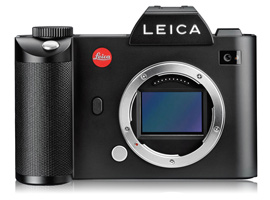



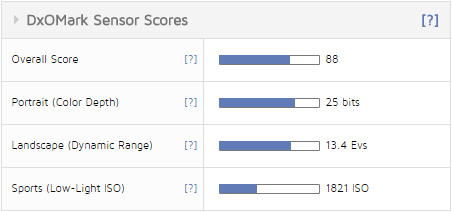
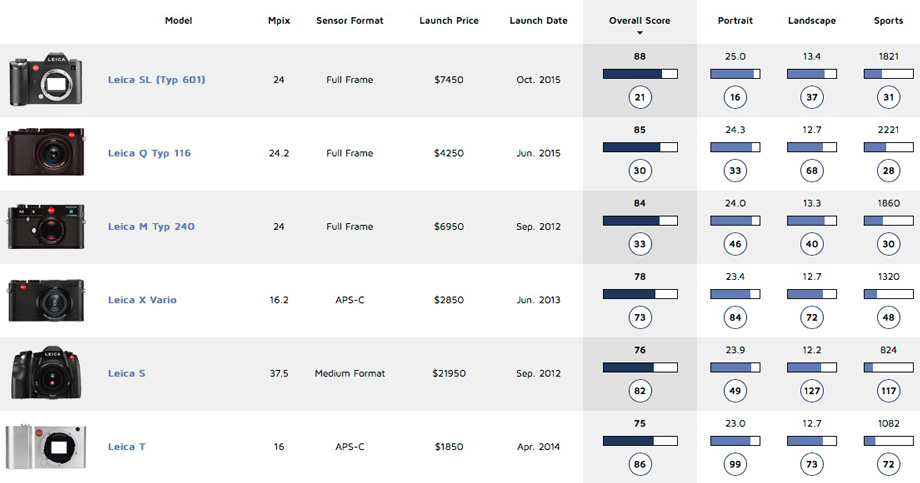
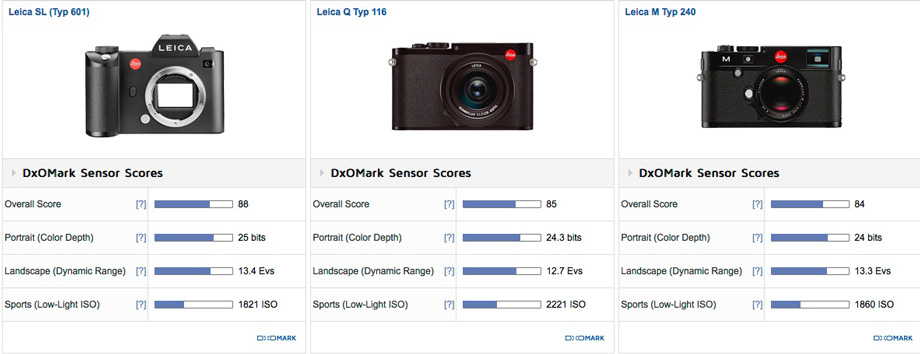
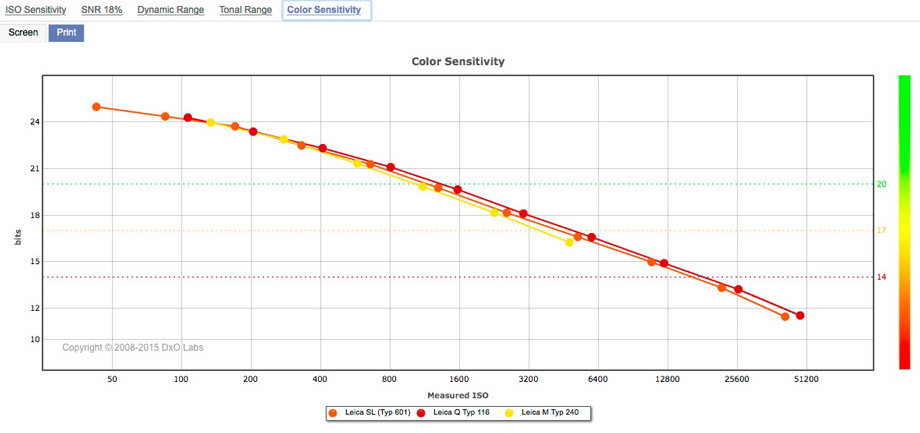
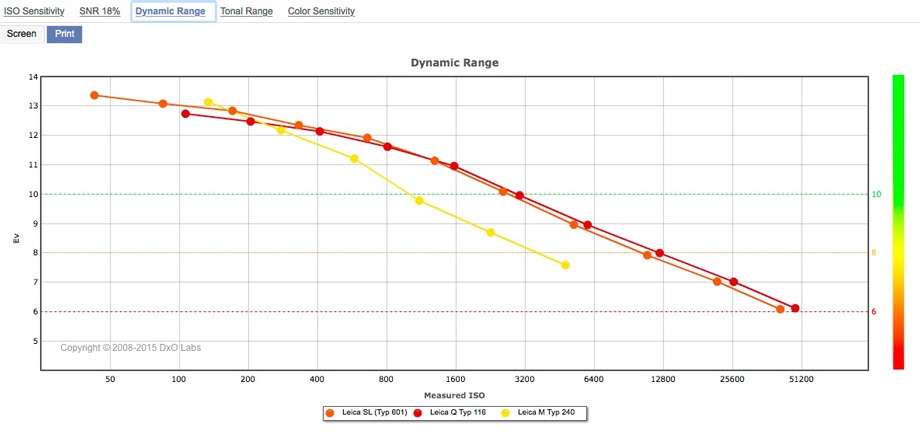
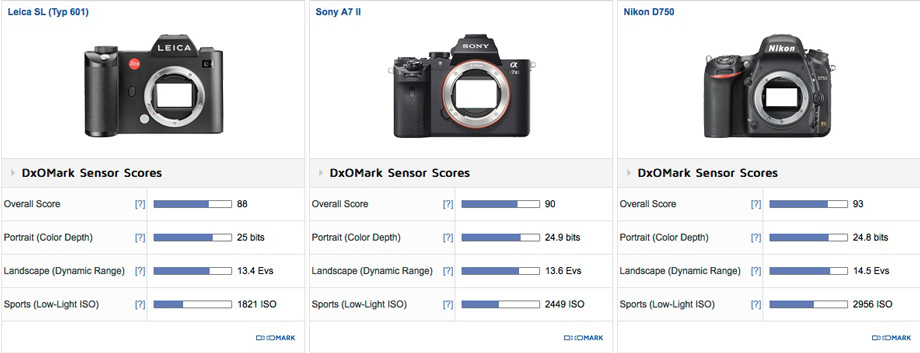
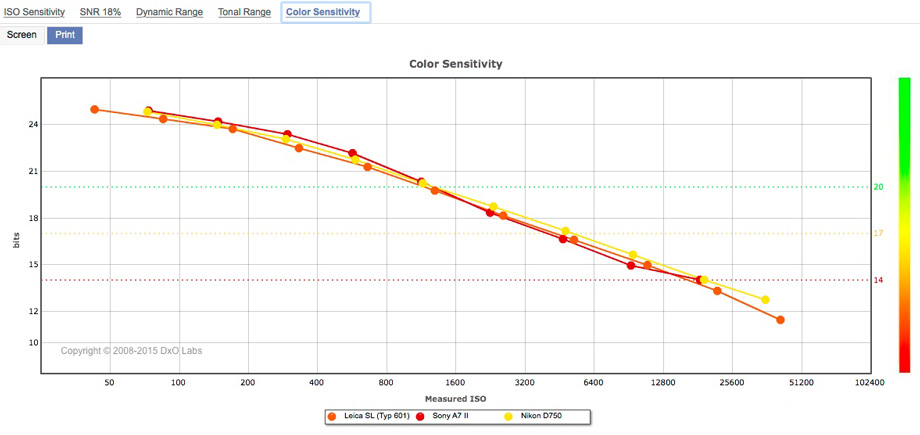
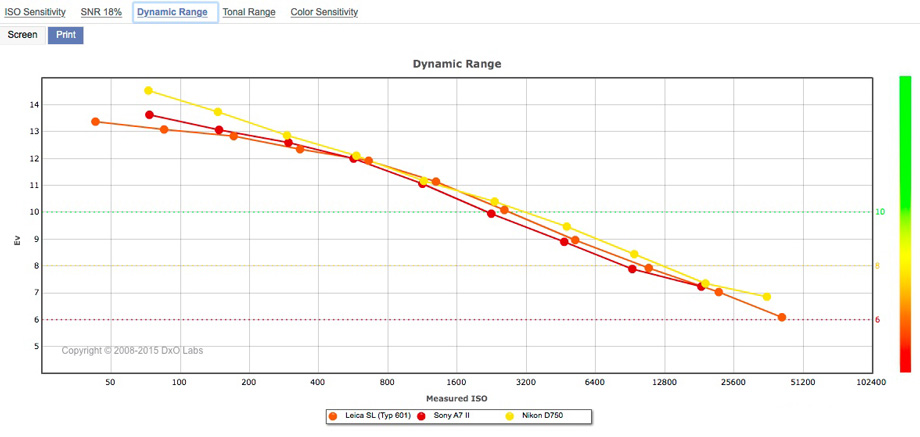
DXOMARK encourages its readers to share comments on the articles. To read or post comments, Disqus cookies are required. Change your Cookies Preferences and read more about our Comment Policy.